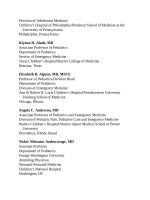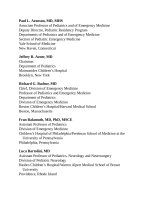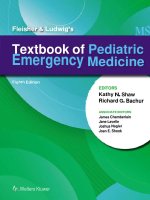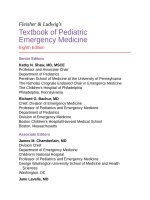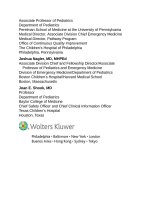Pediatric emergency medicine trisk 0328 0328
Bạn đang xem bản rút gọn của tài liệu. Xem và tải ngay bản đầy đủ của tài liệu tại đây (101.18 KB, 1 trang )
Availability of the referring personnel at the time of transport can also make the
process more efficient for all concerned. Telephone and fax numbers and the
addresses of the referring and primary physicians should be available to the
transport team so follow-up information may be easily conveyed. Likewise, the
referring and primary physicians should be given contact numbers for the
transport team and its medical and administrative directors.
Finally, the family should receive clear preprinted directions to the receiving
facility. Information about the facility, parking, city, local transit, and the visiting
policies of the receiving unit should also be provided. Figure 11.8 demonstrates
the “Welcome Pamphlet” given to families of transport patients of the Children’s
Hospital of Philadelphia; it has much of this information, along with other
frequently asked questions. Notably, enabling a family member to accompany the
transport team has been shown to be important to both the patient and family,
while not diminishing the delivered quality of care. Recognition of the family’s
role in the overall care of the child (“Family-Centered Care”) will pay dividends
to the team, patient, and family.
Patient and Team Safety
Safety is a primary consideration for the transport team. The service and team
should do everything possible to provide for the safety of all involved in the
transport process. Awareness of risks and safety issues is important. This includes
more than providing pediatric medical expertise for the patient during the
transport. It starts with careful vehicle selection, assessment of proper driver or
pilot capabilities, and ongoing certification and licensure requirements. The
transport medical and program director are responsible for continually assessing
the capabilities of the particular modes of transport and competencies of the
personnel involved with those functions. This goes beyond certification and
licensure issues. Active inspections and evaluations, as well as continuous quality
improvement (CQI) issues, are important. Unsafe vehicles or personnel must be
attended to or removed from service.
Air Transport and Safety
The gradual introduction of air medical transport into civilian prehospital care
began in the 1960s. During that time, a National Academy of Sciences Research
Council document recommended the initiation of pilot programs to evaluate
ground and air ambulance services in sparsely populated areas. Since then, air
medical transport has developed into a common part of many EMS systems.




